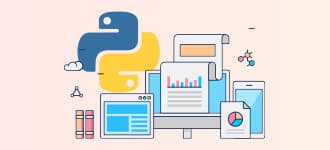Because of its simplicity and ease of use, Python for data science is one of the most popular programming languages in the scientific and research domain. People without engineering backgrounds can easily learn how to use it because of its simplicity and large libraries. Additionally, it works better for rapid prototyping.
AI scientists favour Python as well, with regard to application domains. Developers tended to rely on Java when it came to areas like creating fraud detection algorithms and network security, but they chose Python for data science applications like sentiment analysis and natural language processing (NLP) because it has a large library of tools that make it easier to solve complex business problems and create robust systems. Is Python necessary for learning data science or not? Here we discuss.
What is Python?
Python is an open-source, interpreted, high-level language that offers excellent object-oriented programming techniques. Data science leverages this language in all their projects and is one of the best languages data scientists can leverage. Python offers excellent capabilities for dealing with arithmetic, statistics, and scientific functions. To cope with data science applications, it offers fantastic libraries.
The key features of Python
Despite being a relatively advanced programming language, Python is simple to learn. It can take more time to fully understand Python’s complex concepts, packages, and modules.
- Simple to read and very easy to learn
Python code resembles everyday English terms. The indentations define the code. Due to its simplicity of learning, Python is the perfect tool for novice programmers. It gives programmers the benefit of using fewer lines of code than one to complete tasks. In other words, it is more like playing with it than working with the codes.
- Free and open source
Python is created under an open-source licence that OSI has accepted. It can be downloaded and used in applications free of charge. It can be downloaded and used in applications without costing anything. Additionally, it may be freely changed and distributed again.
- The same code can be used on multiple devices
The code written once can be applied on several machines, making Python portable. Let’s say you use a Mac to write Python programmes. There are no modifications required to run it later on Windows or Linux.
- Dynamically typed
In order to run a programme in any programming language, its type must be declared before a variable can be used. But it is not the same in Python. Here, the type of the variable can be decided during runtime. As a result, Python is now a dynamically typed language.
As an illustration, you don’t need to write int x = 10 when you need to give the integer value of 10 to the variable “x”. Writing x = 10 is all that is required. The fact that Python supports both object-oriented and procedure-oriented programming is one of its key strengths.
Use cases of Python with examples
The following use cases speak of the efficiency of Python for data science.
- Machine intelligence
Python is quite well-liked in the machine learning or AI fields. Despite being an old language, Python has evolved to work with numerous new technologies. Building complex machine learning modules requires a vast array of computations, which Python’s stability makes it capable of handling.
Some of the well-known libraries provided by Python to work on machine learning and artificial intelligence projects are Sensorflow, Numpy, Keras, and Scikit Learn.
- Game development
Python also helps with game development, simple AI, and standard web programming. 3D game development is made possible by Python packages like PyGame and PySoy. Additionally, it offers a library for any topic, regardless of your field.
- Educational sector
Python is one of the most utilised programming languages for creating educational software and online courses. It is a programming language that is user-friendly for beginners and has a low learning curve and a multitude of resources. Python is a very “readable” language, as was already said, and is frequently used for creating online courses.
The benefits of learning Python as a data scientist
If you learn python for data science, you can unlock the following benefits –
- Libraries that can enhance the ease of programming
The large sum of libraries efficient in the working and improving the ease of the programming is its biggest utility for enabling a data scientist to efficiently finish the hard jobs faster and with fewer rewrites. As a data scientist, you should be aware of the following crucial libraries that make Python a trustworthy and effective tool for data analysis and visualisation.
- NumPy assists us with strong multifunctional tools and array objects as one of the most fundamental Python libraries. Many people use NumPy for data analysis. A homogeneous multidimensional array is its main component.
- Matplotlib offers effective and stunning visualisations. Several stories can be written utilising the data that Matplotlib has visualised.
- Pandas are among the most widely used and favoured libraries for data science. Its intended applications include statistical, engineering, social science, and practical data analysis.
- Object and procedure-oriented programming
If data and objects are the main design considerations rather than functions and logic, a programming language is said to be object-oriented. On the other hand, a programming language is procedure-oriented if it emphasises functions (reusable code) more.
Given that it was created as a high-level programming language for general purpose programming, Python supports both procedural and object-oriented programming. Python is a multi-paradigm, allowing you to create programmes or libraries that are primarily procedural, object-oriented, or functional in any combination of these three areas of programming.
- A large, helping community
Leveraging data science using Python has many advantages, one of which is that you’ll have access to a fantastic community of Pythonistas and can even join them. Since it has been around for three decades, Python has been designed to be simple to learn and simple to build with.
There is a sizable and passionate community of Pythonistas out there. They can always help you and can share their tips, answer your questions, correct your code, and discuss new ideas because it has remained relevant to so many people and businesses for such a long time. You can find them anywhere.
R vs Python for data science
Both data scientists and analysts use R and Python frequently, but each has a particular purpose in the process. In essence, Python is a general-purpose language utilised across all types of software engineering and data science, whereas R is used specifically for data analysis and statistics. It is generally a hot topic in Python for data science interview questions.
| Points of comparison | R | Python |
|---|---|---|
| Data exploration | Can determine general patterns from data | Libraries are used to get insights out of data |
| Statistical modelling | Specifically built for statistical analysis | SciPy is library in Python that is efficient for this |
| Data visualisation | Can produce slick, objective visualisations | The Matplotlib library of Python is good for this |
- Data exploration
Although, unlike data analysis, data exploration isn’t used to get the most insights out of the data, it is useful in determining general patterns in it. R was natively developed to achieve this, whereas, in Python, there are separate libraries that can be used to have it done without writing a single line of code.
- Statistical modelling
The process of developing an appropriate model follows the collection and exploration of your data. The process of building a data model, or collection of abstract rules that specify how data pieces relate to each other, frequently using characteristics of the real world, is known as data modelling. We refer to the process of using models to forecast future data as machine learning.
R and Python can both be utilised for statistical modelling. R was specifically built for statistical analysis i.e. making a paper or report, while Python has much better uses because of its general-purpose programming language. SciPy in Python is used for scientific calculations.
- Data visualisation
Data visualisation is an intricate task, and poor results may impact the understanding of the visualisation. When it comes to data visualisation, then R is relatively easier, but you can use Python libraries like Matplotlob to generate graphs and charts for your data. R was developed to display the outcomes of its statistical analysis, but one of its greatest capabilities is data visualisation. Because of this, it’s simple to produce slick, objective visualisations.
However, if you decide against learning Python, you could lose out on a number of worthwhile job prospects.
Master your skills with online MSc in Data Science with MAHE
The online data science programmes offered by Manipal Academy of Higher Education (MAHE) through Online Manipal are a great way to start if you are looking for a lucrative career in the fields of data science and artificial intelligence. Whether you want to work in the industry or move into another field, a data science course taught by experts will help you know how to learn Python for data science.
The course will enable you to improve your analytical ability and problem-solving techniques and gain a command of several programming languages. For more information, visit the Online Manipal website now!
Prepare for your next career milestone with us












